The ICA will be on general strike on Fri 20 Oct. Read more
4 October 2017 – 7 January 2018

‘There’s a question to which no artwork has an answer, to which every artwork is susceptible, which is, so what? There is no answer. You ask it of yourself, as an artist, and there’s only silence. It’s not a nihilistic question, or pointless skepticism, because the silence produced is actually useful. This silence records an echo: the artist has made a noise and prepared some kind of recording device to capture the echo that comes back. Your utterance now has a shadow that cannot be cast off. This is the work.’ – Seth Price, 2007
Seth Price Circa 1981 is a survey exhibition of film and video works by the American artist Seth Price (born 1973, East Jerusalem) stretching from the early 2000s to the present day. It spans the entire Institute of Contemporary Arts building, with works shown in the Cinema, Bookstore, Lower and Upper Galleries, Canteen – and here on the ICA's new website with additional exhibition resources.
The exhibition is a survey of film and video works by the American artist Seth Price. It is a deliberately focused perspective on Price’s output, which also includes sculpture, drawing, print, music, text, fashion, textiles, and web design. Throughout all these media, the unstable nature of what constitutes an image as it passes through different modes of packaging and distribution remains central, while the film and video works in particular trace a shift in emphasis from production to post-production, and from static presentation to circulation.
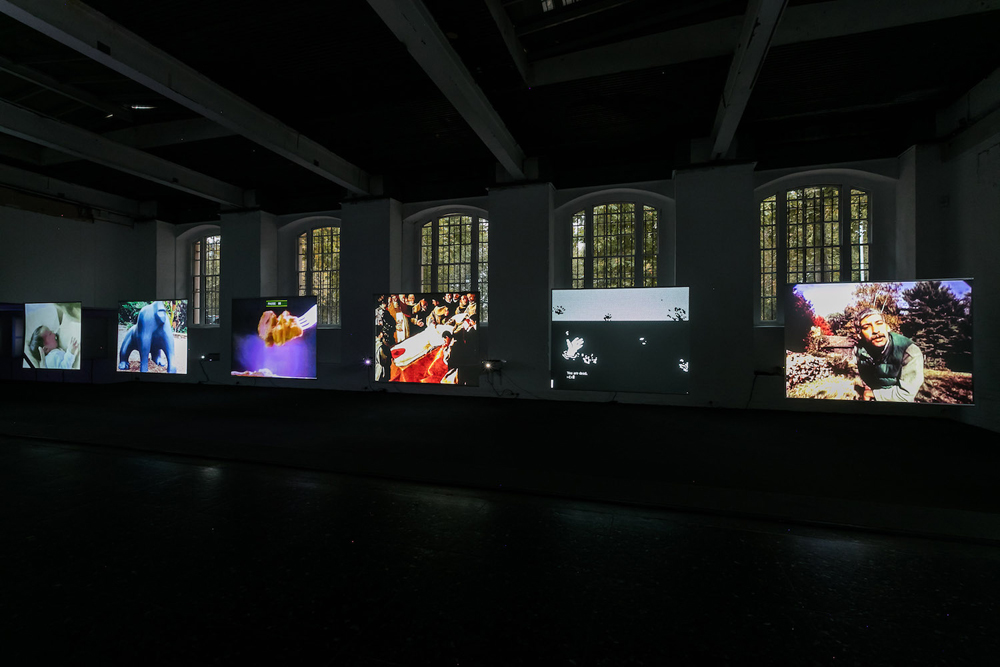
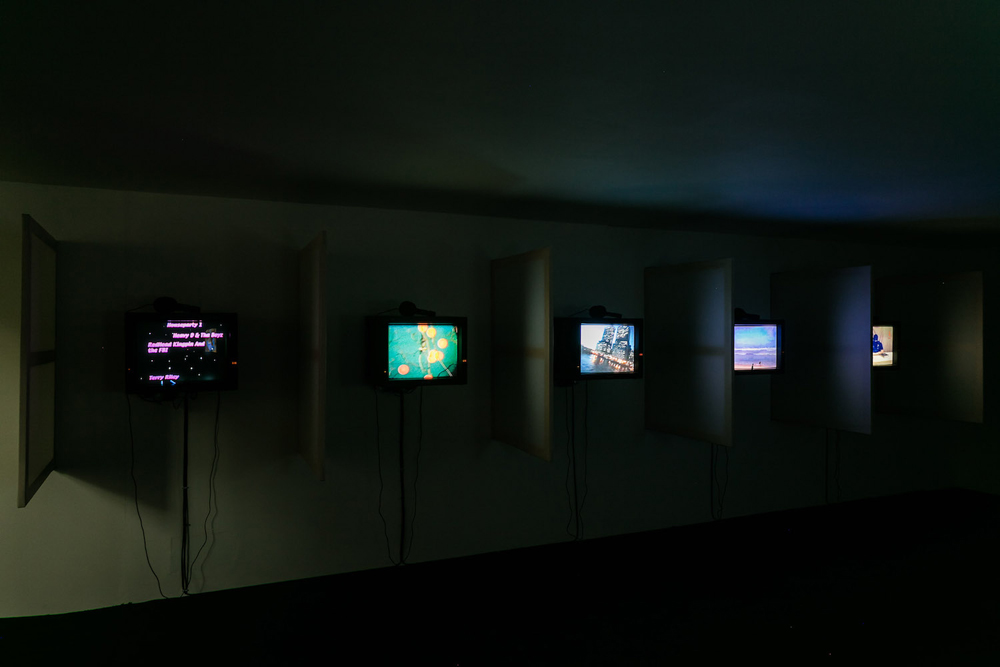
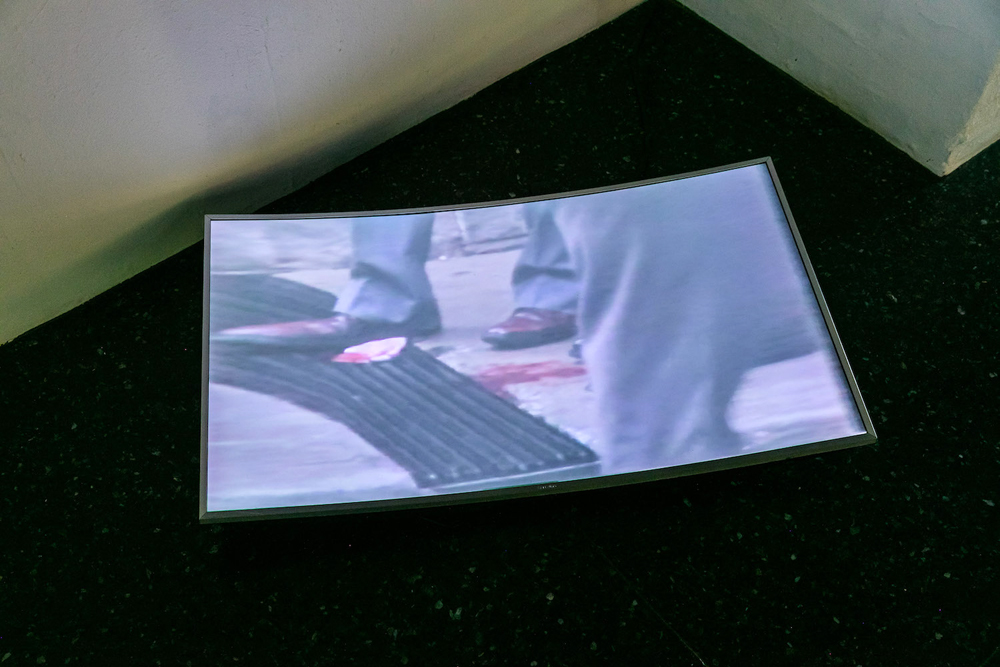
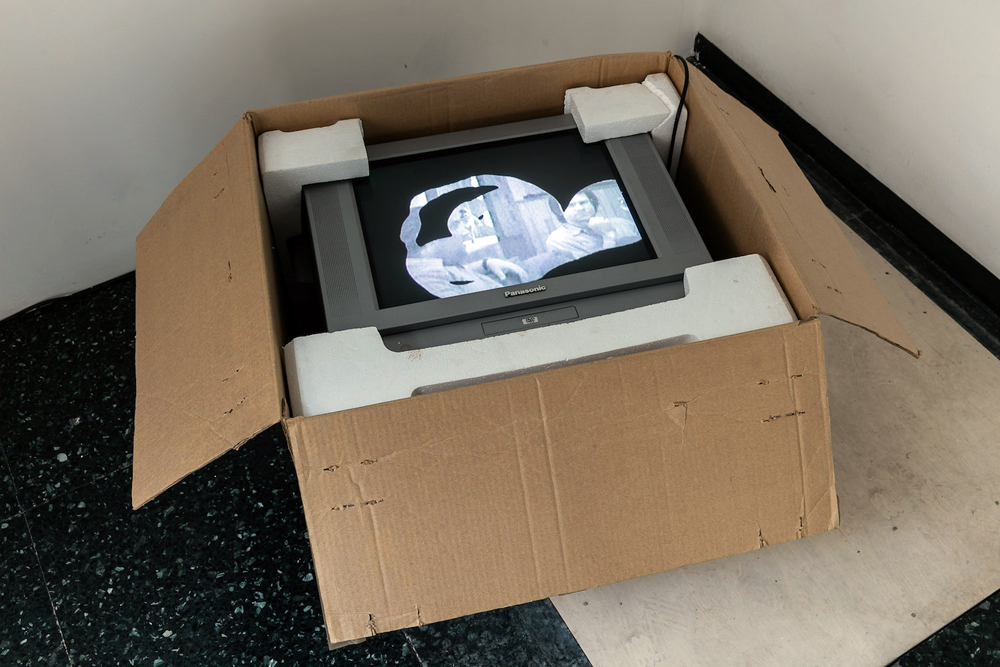
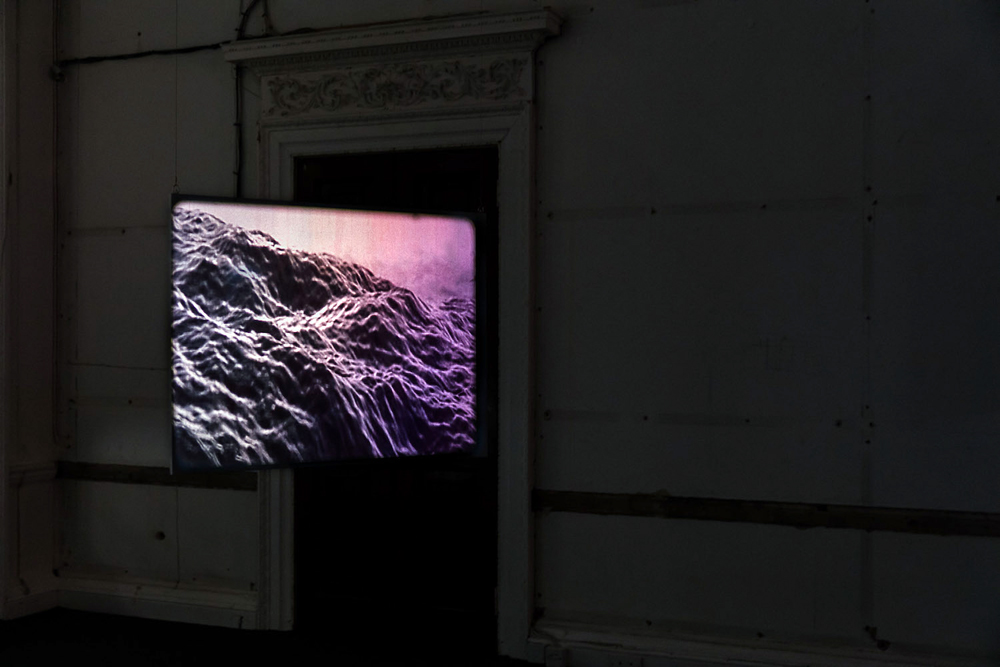
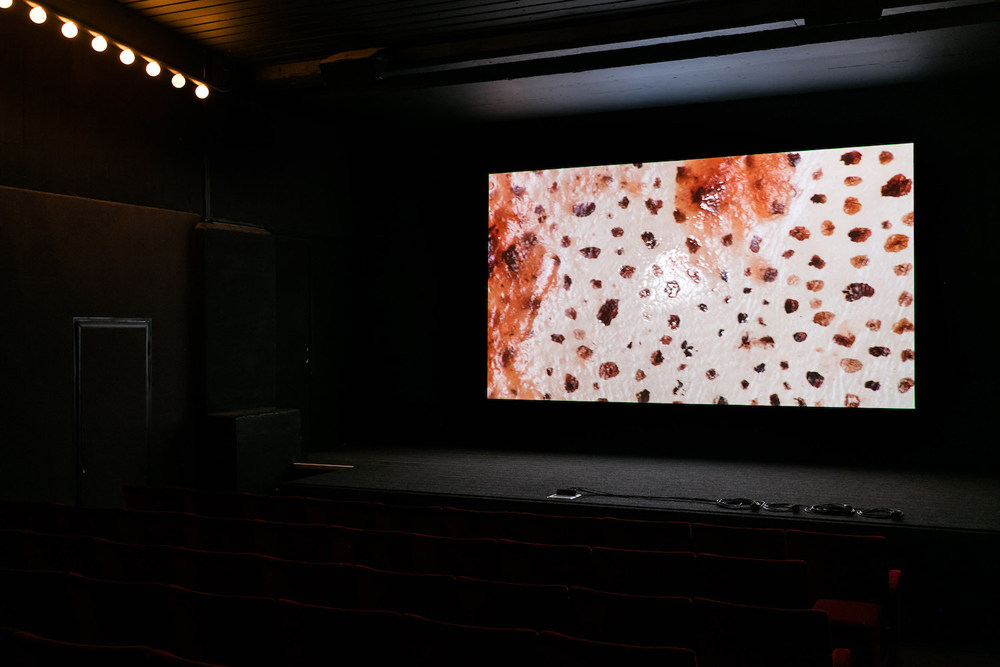
All photographs © Mark Blower
Supported by: Seth Price Exhibition Supporters Circle: Lead support by Eleanor Cayre, plus Isabella Bortolozzi, Gisela Capitain, Chantal Crousel, Marvin Haas, Maurice Marciano, Barbara & Howard Morse, Friedrich Petzel, and Michael Ringier.
While an undergraduate in the 1990s, Price studied with experimental filmmaker Leslie Thornton, producing moving image works that were presented in cinemas and film festivals. Between 1998 and 2005 he worked as technical director at Electronic Arts Intermix (EAI), a pioneering non-profit artist’s video distributor in New York. This background, traversing multiple arenas of film and artist’s video, was highly formative. The access to a historical archive such as EAI’s coincided with the material and existential shifts brought on by the emergence of the Internet as a meta-archive.
In the early 2000s, Price approached the accumulation of visual material online not only as a matter of unprecedented access, but also as a site of potential for ‘re-circulation and recombination along new lines’. In his seminal 2002 essay Dispersion, he pitches an archive of ‘high’ culture, administered through cataloguing, provenance and authenticity, against a promiscuous, un-administered ‘popular’ counterpart: ‘Suppose an artist were to release the work directly into a system that depends on reproduction and distribution for its sustenance, a model that encourages contamination, borrowing, stealing, and horizontal blur?’
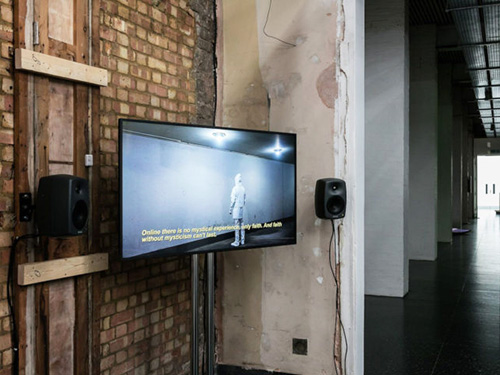
1. Redistribution, 2007–ongoing, single-channel video, length variable (currently 74:07 min.)
Price has extended this proposition into his own work, which is rarely fixed at a single point in time and space, more often reconstituted and re-versioned via different formats and channels. Recurring as a reflexive guide at several points throughout Seth Price Circa 1981, the palimpsest video Redistribution is the most prominent embodiment of these processes. Starting out as a slide lecture Price gave at the Guggenheim Museum in 2007, he took the museum’s documentation of the talk and has since intermittently edited and added to the original footage, incorporating additional subjects and themes along the way. Effectively self-administering his own artistic history, Price’s body of work is reconstituted as deliberately ambiguous and unstable. The version shown here is the fifth, longest iteration to date.
2. Triumf, 2000, single-channel video, 19:18 min.
3. Industrial Synth, 2000, single-channel video, 16:37 min.
4. 'Painting' Sites, 2000, single-channel video, 19:02 min.
5. Two For One Piece, aka ‘Global Taste, A Meal in 3 Courses’ Element 1, by Martha Rosler, 1985, 2002, single-channel video, 29:29 min.
6. Modern Suite, 2002, single-channel video, 10:28 min.
7. Rejected or Unused Clips, Arranged in Order of Importance, 2003, single-channel video, 10:38 min.
8. Romance, 2003, single-channel video, 32:00 min.
Price’s work is marked by the slippages and contradictions between the moving image as experienced by the individual, and by the social body. ‘Collective experience is now based on simultaneous private experiences,’ he writes, ‘distributed across the field of media culture, knit together by ongoing debate, publicity, promotion and discussion.’ The earliest work here, Triumf, documents a performance by Price that parodies a political campaign TV ad, repeated to the point of linguistic dissolution. Connecting a distinctively American pastoral mythos with the libertarian political legacy of Ronald Reagan, Triumf introduces a folkish and mannered storytelling that becomes a recurring motif in these videos.
Made the same year, Industrial Synth mostly departs from the use of filmed footage, relying instead on found materials including passages from text-based video games, online images, graphics and animation. The flow of weird, abstract and often banal residues of technological shifts is accompanied by an occasional solemn voiceover or a conspicuously dated synth backing-track.
Between 2001 and 2007, Price released a number of compilations of niche music genres identifiable as pivot points in the influence of digital technologies on music production. Industrial Synth takes its name from the eponymous ’80s musical genre that was the focus of one such cassette compilation (Industrial Fist) as well as the subject of an article written by Price in 2003 for Sound Collector Audio Review magazine. This text addresses the ‘goth-bleak’ genre as a product of a socio-political context (‘An interlocking world system of Reaganite American might; opposed to it, a foundering socialist international’), technological developments, and the omnipresence of hyper-packaged commodities. The video catalogues these conditions, duplicating the genre’s darkness, implied violence and death drive.
The strange play in Triumf and Industrial Synth between the artist as a discursive actor and the repetitive performance of media archetypes is similarly evident in ‘Painting’ Sites, also from 2000. This work moves even further towards a fully ‘cameraless’ video based entirely on the migration and manipulation of existing media. In the form of a rudimentary slide show, ‘Painting’ Sites takes a compilation of pictures arbitrarily yielded by an Internet search for the word ‘painting’ and peppers them with digital graffiti courtesy of editing software. When Price began the work, automated image-search tools did not yet exist online; instead, he used primitive text- based searches, and has included screenshots that capture improperly loaded data along with the occasional lingering cursor. Playing in the ICA Canteen, Romance is a kind of companion piece to ‘Painting’ Sites, silently recording the flow of green-on-black computer script as Price plays the 1970s text-based, open-source video game Adventure
Two For One Piece appropriates one channel of a 1985 video installation by influential American artist Martha Rosler, titled Global Taste, A Meal in 3 Courses, itself a montage of appropriated footage from TV and other mass media advertising that comments on the relentless, gaudy marketing of American food products to an international market. In re-presenting a single channel of the work, Price highlights how both the original footage and Rosler’s compilation have become media artifacts – equally untethered from the systems of value and social effects they initially operated within.
Another slide show (with accompanying poster), Modern Suite is a slow parade of low-resolution pictures of children’s playgrounds – a taxonomy of architectural influence rendered in miniature and painted in primary colours, combined with a soundtrack by Price that apes the conventions of modernist atonal music. The jarring synthesis of music and image combines two discreet formal vernaculars that could be considered the ‘aftereffects’ of modernism.
In a similarly self-reflexive manner to Redistribution, the video Rejected or Unused Clips, Arranged in Order of Importance purports to be a collection of unused leftovers. Despite the assertion of an arrangement based on ‘importance’, in fact it seems wholly abstract – though clear typologies of image material emerge that reflect the preoccupations of other works, from the stylistic qualities of particular graphics packages and commercial or subcultural illustration, to pixellated footage of acts of violence or military weaponry. Meanwhile, Price’s own mock-profound voiceover speaks soberly of religion, technology and the omnipotence of the Internet.
9. COPYRIGHT 2006 SETH PRICE (CBS and ABC news footage with manipulated colour, speed, and aspect ratio), 2006, sculptural installation, 12:48 min.
10. Digital Video Effect: ‘Spills’ (with manipulated home-movie footage shot by Joan Jonas ca. 1970), 2004, TV/DVD player in its original packaging, DVD, 11:57 min. Private Collection
Through all this image-searching and archive-plundering, Price shifts the notion of artistic innovation from the production of objects to what art historian David Joselit has called ‘an epistemology of search’ – the retrieval of content in intelligible patterns. Joselit further claims this is a political as much as an aesthetic procedure.
Price has produced a number of works that isolate ‘digital video effects’ applied to found footage – a process sometimes emphasized by the use of specific sculptural display formats. COPYRIGHT 2006 SETH PRICE, shown on a floor-based curved flatscreen monitor, employs news footage of the attempted assassination of Ronald Reagan in 1981. Manipulating the colour and speed of the video, as well as visibly stretching its aspect ratio to fit the screen, this artifact of recent American political history is untethered from its original, periodised media form, and rendered as a mutable object.
Similarly, Digital Video Effect: ‘Spills’ makes use of a single sequence of art-historical footage, manipulated through the overlay of a morphing liquid spill – an exaggeratedly ‘painterly’ gesture that doubles as a framing device for parts of the image beneath. The footage is a home-movie shot around 1970 by the artist Joan Jonas, showing the artists Richard Serra and Robert Smithson conversing with gallerist Joseph Hellman on the nature of the commercial art market, differing perceptions of value, and the rights of artists after the sale of an artwork.
Digital Video Effect: ‘Spills’ is shown on a TV monitor with inbuilt DVD player, and exhibited in the monitor’s original box – a gesture that at the time of its original presentation likely represented the height of portability for any art collector, but has quickly become dated, entering a different value system based on the rarity of the video’s material host.
11. Auto da Fe, 2000, single-channel video, 3:12 min.
12. Niuew Jacxz Swingje (aka NJS, New Jack Swing, and NJS Map), 2001–2002, single- channel video, length variable (this version 2:21 min.)
13. Non Speech, 2010, online music video, 3:33 min.
14. Die Leguane, 2010, online music video, 2:29 min.
15. No Such Thing aka Happy Boots aka Relaxation, 2010, online music video, 2:40 min.
16. N.Y. Sorrow, 2010, online music video, 3:48 min.
17. Army Jacket, 2010, online music video, 3:44 min.
18. Keep Hollywood Close, 2010, online music video, 2:29 min.
19. The Rolling Skull aka Tale of the Skull, 2010, online music video, 3:52 min.
20. Fire & Smoke aka Pencil Legs, 2010, online music video, 4:47 min.
21. Tale of the Mountains, 2010, online music video, 3:40 min.
22. Sister Ray, 2011, online music video, 2:21 min.
23. Ugly Kill, 2012, online music video, 2:54 min.
24. Lookin’ Bak, 2012, online music video, 2:50 min.
25. Whipz, 2012, online music video, 2:40 min.
26. No Way, 2012, online music video, 4:13 min.
27. Feeling in the Eyes, 2012, online music video, 5:57 min.
28. Sickly Air/Dying Air, 2012, online music video, 4:31 min.
While works such as COPYRIGHT 2006 SETH PRICE and Digital Video Effect: ‘Spills’ encompass their own display conditions, Price has also made video works that circulate freely via platforms beyond the confines of gallery presentation. Since 2010, he has focused on the creation of short-form music videos for web distribution as a means to newly circulate songs and spoken-word tracks produced from the early 2000s onwards.
His music, which is generally rooted in research into historical shifts in the production of electronic avant-garde, synth and dance music, has been published in album form on vinyl, cassette and CD, and as digital sound files; meanwhile, the music videos have paired published and unpublished tracks with material from an accumulated archive of found and original video footage. These videos have then been (re-)inserted into the YouTube network.
The visual material used in the music videos often captures key global media events of the early 21st century: helicopter footage shot by Price of the World Trade Center before 9/11; Jihadi propaganda videos posted online; home video footage of the tsunami in South Asia in 2004. Although Price does not consider these videos artworks per se, he has occasionally presented them in arcade-like individual viewing stations installed in galleries – a return to an early history of film where coin-operated booths ‘ensured a controlled, strictly private experience of the moving image’ (an odd analogue to the contemporary individual viewing experience of web-based media).

29. Untitled Film/Right, 2006, 16-mm lm, 11:36 min.loop

30. Untitled Film/Left, 2006, 16-mm lm, 12 min.loop
In Price’s work, the movement of images between the spaces of viewing and the conditions of circulation render them at once material and abstract. We are aware of an image’s manipulability, and of its dissolution beyond meaning into a series of procedures. Price draws a comparison between this endeavour and structural/materialist film of the 1970s that occupied a similarly liminal space between cinema and art, and sought to demystify film processes.
The companion 16mm film works Untitled Film/Right and Untitled Film/Left each function through an inversion of technological progress: the transference of digital imagery into analogue film. In the case of Untitled Film/Right, what is transferred is not filmed footage but a computer generated rendering of a wave, originally in black & white but digitally enhanced by Price to cycle through a spectrum of colours. The extended and looped clip is an uncannily repetitive algorithmic abstraction; it is also a commodity form, purchased by the artist as a stock animation with full screening rights. Designed for use within the voracious cycle of commercial design and advertising, Price’s actions serve to insert the clip within a slower, mesmeric temporality – a resistance to what he describes as ‘the contemporary mandate for speed’.
Untitled Film/Left applies a similar logic to Price’s own work, essentially a sampler of audio and visual sections from his previous videos edited together in a montage that generates new relationships and affects. In its original showing, the film formed one part of an exhibition spanning three different galleries; the other sites exhibited a video version of the exact same montage, and Untitled Film/Right. Each of the three galleries had contributed to the development of an economy of sale and distribution around Price’s videos. Untitled Film/Left cannabalises and repackages that economy by setting up a form of renewed access to works previously removed into private hands. Equally, its transitions, overlays and repetitions point to a deeper excavation of a particularly U.S.-centric, late 20th-century world order – a ‘global taste’ underpinned by violence, design and forms of property.
31. Social Synth, 2017, video for projection, 11:10 min.loop
Returning Price’s work to the cinematheque, his most recent video is presented in the ICA Cinema. Like Untitled Film/Right, Social Synth is an abstraction enabled by technological development: a computer-controlled robot camera was employed to gather thousands of close-up images of the skin of a squid, which were then stitched together algorithmically and imported into a 3D cinema programme to add motion and light effects. The result is an uncanny, other-wordly landscape of pure surface.



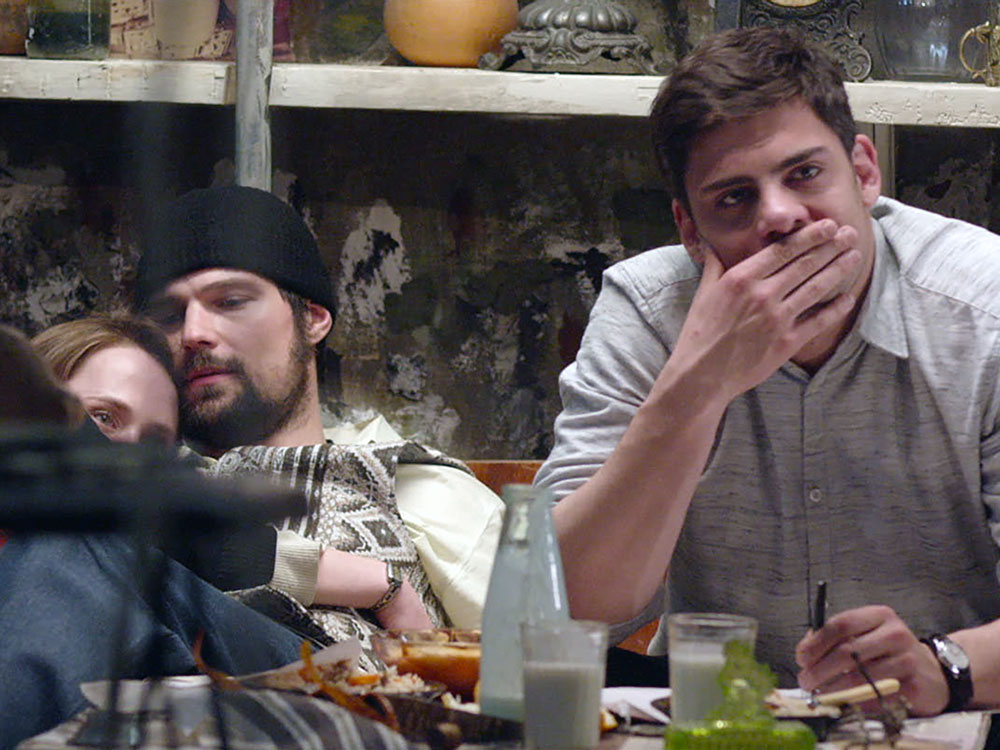








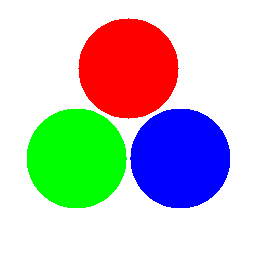

no. 236848.